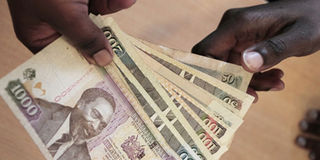Kenya loses Sh73bn to crime, tax evasion in 10 years

Kenya has lost about Sh73 billion (US$ 847 million) in crime, corruption, and tax evasion for a decade. PHOTO | EMMA NZIOKA | FILE
What you need to know:
- Report disclosed that nearly $6 trillion was stolen from developing countries in decade between 2002 and 2011.
- The report, “Illicit Financial Flows from Developing Countries: 2002-2011 is GFI’s 2013 annual update on the amount of money flowing out of developing economies as a result of crime, corruption and tax evasion.
- Poor countries haemorrhaged nearly a trillion dollars from their economies in 2011 that could have been invested in local businesses, healthcare, education, or infrastructure.
Kenya has lost about Sh73 billion (US$ 847 million) in crime, corruption, and tax evasion for a decade.
This is according to a new study published by Global Financial Integrity (GFI), a Washington, DC-based research and advocacy organisation has revealed.
The study that was carried out between 2002 and 2011, however, indicates that in 2006, Kenya had no case of illicit financial outflows as well as between 2008 and 2011.
It reveals that most of the activities took place in 2003, 2004, 2005 and 2007 in the country.
The study also indicates that crime, corruption, and tax evasion drained US$946.7 billion from the developing countries in 2011, 13.7 percentage more than 2010—when illicit financial outflows totalled US$832.4 billion.
It also disclosed that nearly $6 trillion was stolen from developing countries in decade between 2002 and 2011.
In East Africa, Uganda leads in the illicit financial outflows with accumulative of US$7,373million followed by Tanzania which had US$4,441 while Nigeria led in Africa with US$119,784.
China, Russia, Mexico, Malaysia, India in declining order are biggest exporters of illicit capital over decade while Sub-Saharan Africa suffers biggest Illicit outflows.
The report, “Illicit Financial Flows from Developing Countries: 2002-2011 is GFI’s 2013 annual update on the amount of money flowing out of developing economies as a result of crime, corruption and tax evasion.
FINANCIAL CRISIS
“As the world economy sputters along in the wake of the global financial crisis, the illicit underworld is thriving siphoning more and more money from developing countries each year,” said GFI President Raymond Baker.
He went on: “Anonymous shell companies, tax haven secrecy, and trade-based money laundering techniques drained nearly a trillion dollars from the world’s poorest in 2011, at a time when rich and poor nations alike are struggling to spur economic growth.”
He said that while the global momentum has been building over the past year to curtail the problem, it’s time to act.
However, GFI Chief Economist Dev Kar, who served as a senior economist at the International Monetary Fund before joining GFI in January 2008 said that much of the proceeds of drug trafficking, human smuggling, and other criminal activities, which are often settled in cash, were not included in the estimates.
“It’s extremely troubling to note just how fast illicit flows are growing,” stated Dr Kar. This underscores the urgency with which policymakers should address illicit financial flows,” said Dr Kar.
He said that the US$946.7 billion that flowed illicitly out of developing countries in 2011 was approximately 10 times more than the US$93.8 billion official development assistance (ODA) that went into these specific 150 developing countries.
He noted that for every US$1 in economic development assistance going into a developing country, roughly US$10 of capital are lost via illicit outflows.
“Illicit financial flows have major consequences for developing economies,” explained Mr Brian LeBlanc, the co-author of the report.
He said that poor countries haemorrhaged nearly a trillion dollars from their economies in 2011 that could have been invested in local businesses, healthcare, education, or infrastructure.
“This is nearly a trillion dollars that could have been used to help pull people out of poverty and save lives. Without concrete action, the drain on the developing world is only going to grow larger,” he said.
Nigeria and South Africa made it to the 25 biggest exporters of illicit financial flows over the decade and who also includes China, Russia, Mexico, India, Malaysia, Saudi Arabia, Brazil, Indonesia, Iraq, Thailand, United Arabs Emirates, Philippines, Costa Rica, Belarus, Qatarm, Poland, Serbia, Chile, Paraguay, Venezuela, Brunei, Panama and Turkey.
Sudan, South Africa, Egypt and Nigeria also made it to the list of top exporters of illegal capital in 2011 while the globally, annual illicit financial outflows averaged 4 per cent of GDP.
Russia was rated as the second biggest exporter of illicit capital over the decade, with US$880.96 billion in illicit outflows at that time—estimated that the Russian economy lost at least US$211.5 billion in illegal capital flight between 1994 and 2011.
China was rated as the largest cumulative exporter of illegal capital flight, with outflows totalling $1.08 trillion over the decade.





